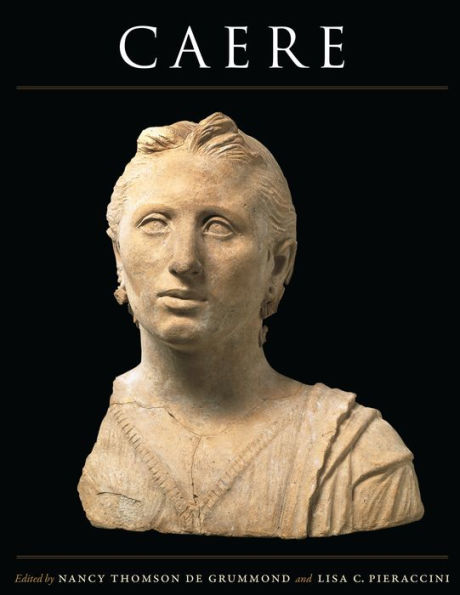

eBook
Available on Compatible NOOK devices, the free NOOK App and in My Digital Library.
Related collections and offers
Overview
The Etruscan city of Caere and eleven other Etruscan city-states were among the first urban centers in ancient Italy. Roman descriptions of Etruscan cities highlight their wealth, beauty, and formidable defenses. Although Caere left little written historical record outside of funerary inscriptions, its complex story can be deciphered by analyzing surviving material culture, including architecture, tomb paintings, temples, sanctuaries, and materials such as terracotta, bronze, gold, and amber found in Etruscan crafts. Studying Caere provides valuable insight not only into Etruscan history and culture but more broadly into urbanism and the development of urban centers across ancient Italy.
Comprehensive in scope, Caere is the first English-language book dedicated to the study of its eponymous city. Collecting the work of an international team of scholars, it features chapters on a wide range of topics, such as Caere’s formation and history, economy, foreign relations, trade networks, art, funerary traditions, built environment, religion, daily life, and rediscovery. Extensively illustrated throughout, Caere presents new perspectives on and analysis of not just Etruscan civilization but also the city’s role in the wider pan-Mediterranean basin.

Product Details
| ISBN-13: | 9781477310465 |
|---|---|
| Publisher: | University of Texas Press |
| Publication date: | 11/22/2016 |
| Series: | Cities and Communities of the Etruscans |
| Sold by: | Barnes & Noble |
| Format: | eBook |
| Pages: | 336 |
| File size: | 74 MB |
| Note: | This product may take a few minutes to download. |
About the Author
Table of Contents
- List of Illustrations
- Preface (Lisa C. Pieraccini)
- Acknowledgments
- Introduction to the Volume (Lisa C. Pieraccini)
- List of Abbreviations
- A Note on Terminology
- Caere: An Overview (Ingrid Edlund-Berry)
- Part I. Historical Identity and Physical Setting
- 1. The History (Mario Torelli)
- 2. Topography and Natural Resources, Agriculture and Economy (Ingrid Edlund-Berry)
- 3. The Orientalizing Period: Material and Cultural Connections (Orlando Cerasuolo)
- 4. Literacy and Epigraphy of an Etruscan Town (Rex Wallace)
- 5. The Urban Area (Vincenzo Bellelli)
- Part II. Connections and Interactions around the Mediterranean
- 6. Innovations: Myth, Inscriptions, and Meaning (Larissa Bonfante)
- 7. Ports: Trade, Cultural Connections, Sanctuaries, and Emporia (Laura M. Michetti)
- 8. Prisoners and Plagues: The Battle over Alalia (Jean MacIntosh Turfa)
- Part III. Cities of the Dead
- 9. Architecture of the Tombs (Stephan Steingräber)
- 10. Early Painted Tombs in Context (Alessandro Naso)
- Part IV. Religion and Civic Identity
- 11. Temple Décor and Civic Pride
- Caere’s Place in the Evolution of Etruscan Architectural Terracotta Decoration, 550–510 BCE (Nancy Winter)
- New Perspectives on the Acroteria of Caeretan Temples (Patricia S. Lulof)
- 12. Funerals and Feasting: Life at the Tomb (Lisa C. Pieraccini)
- 13. Ritual and Religion: Life at the Sanctuaries (Nancy Thomson de Grummond)
- 11. Temple Décor and Civic Pride
- Part V. Art and Artisans
- 14. Workshops, Artistic Exchange, and the Economy (Giovannangelo Camporeale)
- 15. Bucchero (Tom Rasmussen)
- 16. Terracotta “Sarcophagi” and Ash Urns (Nancy Thomson de Grummond)
- 17. Stamped Braziers and Pithoi (Lisa C. Pieraccini)
- 18. Gold and Ivory (Richard Daniel De Puma)
- 19. Amber (Faya Causey)
- 20. The Terracotta Votives: Aspects of Cult, Artistic Exchange, and Workshop Practices (Helen Nagy)
- 21. Painted Plaques (Francesco Roncalli)
- 22. Archaic Painted Pottery (700–500 BCE) (Maurizio Harari)
- 23. Classical and Hellenistic Painted Pottery (Laura Ambrosini)
- Part VI. Later Years
- 24. The Roman Period (Mario Torelli)
- 25. Rediscovery and Recognition (Nancy Thomson de Grummond)
- Appendix A. A Chronology of Caere
- Appendix B. Complete List of Publications and Excavations by Professor Mario A. Del Chiaro
- Index
What People are Saying About This
"Caere is important for experts in Etruscan archaeology because it brings under one roof the latest published research on the material culture of Caere and will certainly represent an immensely useful tool for our own studies. There is no doubt, therefore, that the book represents a significant contribution to the field. This is also the case for Mediterranean archaeology, where scholars specializing in specific regions of the basin always need access to up-to-date and in-depth investigations of single sites outside their own region."
"Caere manages to put everything an Etruscan scholar ever needed to know about researching Caere into one place and is therefore unique in our field. It will become the definitive book on the site of Caere, and it is also highly useful as a microcosm for understanding the Etruscans in general. This is perhaps the greatest array of living Etruscan scholars that has ever been put together in one work."
